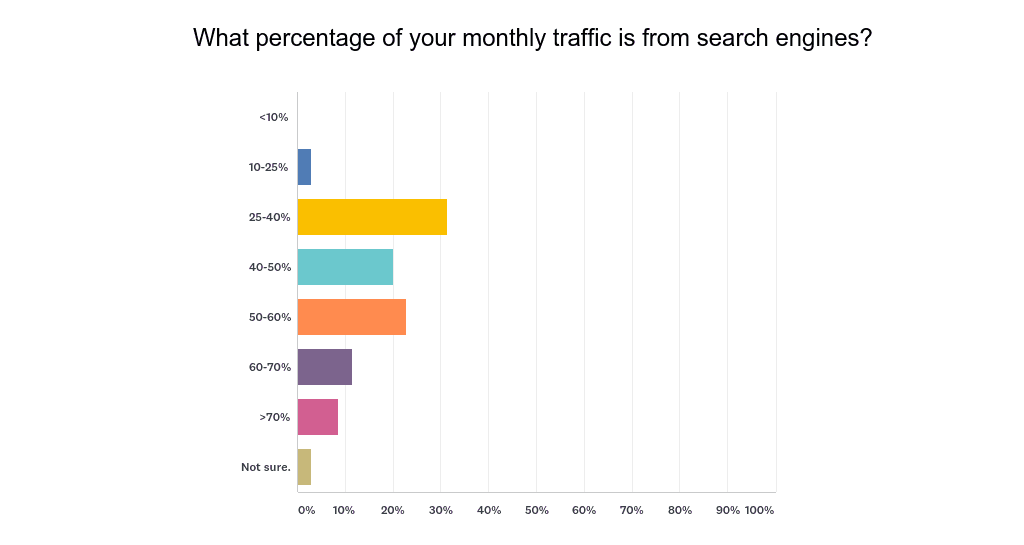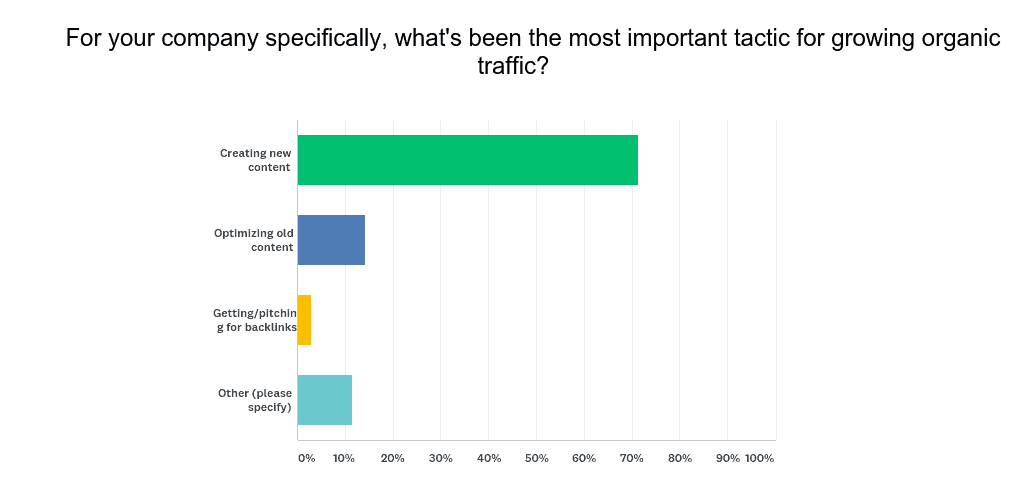Table of contents
Organic traffic is hugely valuable, and marketers know it.
Growing your organic traffic, however, is a bit more nebulous.
Everyone wants to get more visitors from search engines, but not everyone is sure how to do it. So, we asked dozens of marketers for their single best tip on how to boost organic traffic.
First, though, we needed to level set to find out just how important organic traffic is to our respondents.
The largest group of marketers (31%) say that organic traffic represents between 25-40% of their overall website traffic. [Tweet this stat.]

But, there are some overachievers too. Almost 20% of marketers get more than 60% of their traffic from search engines. [Tweet this stat.] So how did these companies increase their percentage of organic traffic more than the rest?
We wanted to know that, too.
71% of the marketers said that creating new content is their most important tactic for growing their organic traffic. [Tweet this stat.]

A few are optimizing old content or trying other methods, and a very small percentage prioritize backlinks over everything else.
So, new content creation was the overwhelming priority amongst marketers.
You might think that it’s by far and away the best way to increase your organic traffic, but when we started looking into the responses we found that there’s a lot of nuance in determining how to boost search engine traffic.
Here’s what we learned.
Editor’s note: You can use Google Analytics’ to pull a ton of great insights about your organic traffic growth. Here’s one free template in particular that offers a snapshot of all of your new visitors from organic search.
Create new content
While almost everyone said that creating content was the best way to increase organic traffic, respondents differed in exactly how they approached this task. But, almost everyone agreed that the single best way to increase organic traffic is to blog regularly.
Blog regularly
Shane Carter, digital marketing specialist from Web Geeks, sums it up nicely: “Regular blog posts about current topics keep your website updated, relevant, and show that your brand knows what is going on in the industry.”
Of course, it’s not just as simple as writing blog posts on whatever you want. You need to offer value to your readers.
Identify the gaps
Prathamesh Yeotekar, SEO specialist at Valasys Business Solution, points out that this isn’t easy: “making vital content is harder than it used to be . . . you have to ensure your content offers something your competition doesn’t.”
Finding a niche for your content creation is crucial, but it can also be time-consuming.
Millions of posts are published every day, and standing out in that crowded market is difficult. But our respondents had some great advice for creating content that helps grow your traffic.
Consistency
Anna Wolf, founder of SuperScript Marketing, cited a case study from one of their clients. The client posted a single SEO-optimized blog post per week for a year, and that increased their monthly organic clicks by 180%. “It’s a great example of how, when it comes to blogging, consistency is more important than frequency,” said Wolf.
(Though, to be fair, Josh Spilker, content manager at ClickUp, suggests posting three to four times a week when you’re getting started. It just goes to show that there are multiple viable ways to create content and boost your traffic.)
Go evergreen
Everyone agrees, however, that your content has to be useful. “The most effective way of continuously growing your organic traffic is by creating evergreen content which is highly searchable,” says SEO Hacker’s editor-in-chief, Sean Si.
Evergreen content isn’t a post about the latest feature in your product or a new pricing structure for your service. It’s about solving your customers’ (and, more importantly, your potential customers’) problems.
What are their pain points? And what can you do to help?
Don’t limit yourself to blogging. Emma Knightly, digital marketing specialist at The Digital Marketing Institute, has found that blog posts resonate with readers, but so do case studies, how-to videos, whitepapers, and ebooks.
Target keywords
Anna Wolf mentioned SEO-optimized posts in her above response. This was another common refrain we heard from marketers in talking about how to boost organic traffic.
Adam Rowles, Inbound Marketing Agency’s managing director, told us how his agency goes about making the most of keywords:
- Write on keywords topics you want to rank for
- Use Quora to refine topic to answer a common question
- Use the exact keyword in your SEO title
- Add an exact hyperlink to the page you want to rank
(Rowles also noted that the page you want to rank is usually a commercial page and that using exact internal links has worked well for them—but stressed that they don’t overdo it.)
The combination of creating new content and optimizing that content for specific keywords has become the go-to strategy for nearly every campaign aimed at generating organic traffic. It wasn’t a huge surprise that SEO played a central role in many marketing campaigns.
Brittany Valli, digital strategist at Intuitive Digital, did share an interesting strategy that we didn’t hear from anyone else, though.
Her agency reviews its keyword targets once each year, which gives their content team “a roadmap when it comes to updating our content, page titles, and meta descriptions for our site.”
It’s easy to target a few keywords, build up some content around them, and then completely forget about them. But using Intuitive’s strategy keeps content fresh and helps marketers stay up to date on what’s working, what’s not, and how the market has changed.
(Valli uses Google Search Console for query and click data, and Ahrefs for keyword research. Google Search Console is a free tool, and you grab some really deep insights from it using this dashboard alongside it.)
Be smart about content structure
In a time when nearly every company is blogging and optimizing their content, you need to do more to stand out.
Creating the right content is important—but its relationship to the rest of the content on your site might be even more important.
The Pillar/Cluster model
“[Organize] your blog into a topic cluster,” says Casper Kraken, founder of Bureau Kraken. These clusters focus on a strong topic that your company wants to be known for. “Then do 4–12 posts with related sub-topics that all touch on different aspects of the main topic.”
It’s a strategy that’s been getting more popular. And it works. Campaign Creators’ marketing manager, Tammy Duggan-Herd, shared a case study with us: after implementing a content pillar strategy (just another name for the topic cluster method above), her company increased their organic traffic by 390% in nine months.
The process is simple. Tammy mapped out her customers’ core problems, then identified keywords that those customers might search for.
After three months of organizing and optimizing old content, and another six months of creating new content, Campaign Creators saw a significant increase in organic traffic.
“The age of keyword-based SEO is dead,” says Tammy. “Search algorithms have evolved to the point where they can understand the topical context behind the search intent.”
Search engines are getting smarter, and to keep up, companies need to show their expertise in topic areas—not on single keywords.
Let others help you
Creating optimized content is a proven, effective method for boosting organic traffic.
But it takes a lot of time—there’s planning, research, writing, editing, optimization, promotion, and more. Not every company has the time or money to do that. But even with a small marketing team, you have options.
“We grew our website traffic from a few thousand to 60,000 sessions in 18 months with just 1.5 full-time marketers,” says Peter Caputa, our own CEO.
Around 60% of that growth has come from organic traffic. And we only have 1.5 full-time marketers. How’d we do it?
“We spent more time asking others to contribute to our content than writing articles ourselves,” said Caputa.
By partnering with marketing agencies and thought leaders, we’ve been able to produce in-depth guides on a wide variety of topics. Over 1,200 experts have contributed to our articles, and that’s been a huge boost to our rankings in very competitive keywords.
GlobalOwls has tapped into a similar method by posting short questions that marketers around the world can answer. Founder Rau Tiru says it’s “a highly effective way to scale great content without having to spend too much time writing the content ourselves.”
Instead, GlobalOwls focuses on promoting the best submissions.
But simple guest posts will do the trick, too.
Michael Schiemer, owner of Marketing Masterminds, emphasized accepting a wide variety of guest posts on your blog. Even when you’re not sure if they fit your brand: “Some of the guest blog posts that I was unsure of and didn’t expect to do very well have become top traffic generators, bringing in tens of thousands of readers and the revenue-generating opportunities that come along with that traffic,” said Schiemer.
This strategy helped grow Marketing Masterminds’ organic traffic by over 200% in the past year.
Update older content
Posting new content isn’t the only way to get more organic traffic. If you’ve been blogging or creating content on your site for a while, you have a treasure trove of opportunity just waiting to be taken advantage of.
Brian Schofield, search engine marketing lead at Trailblaze Marketing, explains one of the reasons why this is so important: there’s “nothing worse than an outdated piece of content,” he says, and “if I see a post was created more than a year ago, I generally go back and find something more recent.”
So Trailblaze makes sure their content never falls behind. “By taking just one or two days each quarter to add quotes from influencers, updated statistics, and refreshed copy, you’re sending relevancy signals to search engines, which improve rankings,” said Schofield.
It’s a simple tactic, but it’s effective.
Junto’s content specialist, Darin Evangelista, takes a more analytical approach: “We take data from Search Console and enter it into a spreadsheet that looks at a keyword’s position and CTR and compares it to the average CTR for that position. This helps us quickly identify content that is not getting the clicks it deserves.”
Using this information with an in-house tool helps Junto estimate the ROI of revamping a piece of content. Using this information, they tackle content that will give them the biggest boost in organic traffic.
(It’s worth pointing out here that analytics data is useful throughout the entire process. By analyzing how your old content is performing, you can see which topics and formats are getting the most traction. Then you just stick with it, says Shafi Khan, manager of BlogCharge.
Find what works for you
Of course, every company needs to find their own strategy.
Developing and optimizing content was by far the most commonly suggested tactic. But we had some others, as well. Kath Chalhoub, digital marketing lead at Web Profits, pointed out the value of leveraging key opinion leaders into your strategy.
Andrew Vinas, search strategist at Organik SEO, highlighted the importance of optimizing your landing pages.
demandDrive’s director of marketing, AJ Alonzo, mentioned that no matter which strategy you take, it’s important to keep your social media engagement high (and recommends social scheduling tools like Hootsuite).
Dario Sipos, managing partner at DWR, shared his success with infographics.
Take the time to figure out what your readers value and what will drive organic traffic. Then do what you can to keep growing it. And remember that content marketing is all about adding value. If you’re not answering your readers’ questions and solving their problems, they’ll go somewhere else.
Have you used any of these tactics to increase your search traffic? Did they work? Or have you tried another method we didn’t discuss here?
We’d love to hear about it. Let us know in the comments.












